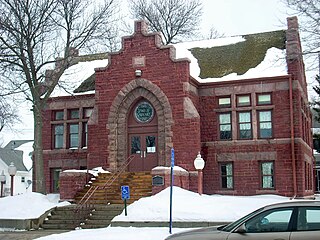
William LaBarthe Steele was an American architect. He is considered a principal member of the Prairie School Architectural Movement during the early 20th century.
Purcell & Elmslie (P&E) was the most widely know iteration of a progressive American architectural practice. P&E was the second most commissioned firm of the Prairie School, after Frank Lloyd Wright. The firm in all iterations was active from 1907 to 1921, with their most famous work being done between 1913 and 1921.

Reuben Harrison Hunt, also known as R. H. Hunt, was an American architect who spent most of his life in Chattanooga, Tennessee. He is considered to have been one of the city's most significant early architects. He also designed major public building projects in other states. He was a principal of the R.H. Hunt and Co. firm.
Sidney Rose Badgley was a prominent start-of-the-20th-century Canadian-born architect. He was active throughout the United States and Canada, with a significant body of work in Cleveland.

Wilson Brothers & Company was a prominent Victorian-era architecture and engineering firm established in Philadelphia, Pennsylvania, that was especially noted for its structural expertise. The brothers designed or contributed engineering work to hundreds of bridges, railroad stations and industrial buildings, including the principal buildings at the 1876 Centennial Exposition. They also designed churches, hospitals, schools, hotels and private residences. Among their surviving major works are the Pennsylvania Railroad, Connecting Railway Bridge over the Schuylkill River (1866–67), the main building of Drexel University (1888–91), and the train shed of Reading Terminal (1891–93), all in Philadelphia.
Charles L. Carson, was an architect born in Baltimore, the oldest son of Daniel Carson, a builder, and one of the founders of the Baltimore chapter of AIA. Carson had little formal training as an architect. Around 1870 he partnered with Thomas Dixon (architect) while taking drawing lessons at the Maryland Institute College of Art. Carson and Dixon worked from their offices at 117 Baltimore Street as Thomas Dixon and Charles L. Carson until sometime before 1877 when the partnership was dissolved. In 1888 he hired Joseph Evans Sperry who became his chief assistant, and later his partner and successor.

The Burlington, Cedar Rapids and Northern Railway (BCR&N) was a railroad that operated in the United States from 1876 to 1903. It was formed to take over the operations of the bankrupt Burlington, Cedar Rapids and Minnesota Railway, which was, in turn, the result of merging several predecessor lines, the construction of which began in 1869. The corporate headquarters were in Cedar Rapids, Iowa, and it had operations in Iowa and in Minnesota. It was succeeded by the Chicago, Rock Island and Pacific Railway.
Hobart Brown Upjohn (1876–1949) was an American architect, best known for designing a number of ecclesiastical and educational structures in New York and in North Carolina. He also designed a number of significant private homes. His firm produced a total of about 150 projects, a third of which were in North Carolina.

The Ausadie Building, at 845 First Ave. SE, in Cedar Rapids, Iowa is a historic building that is listed on the National Register of Historic Places (NRHP). It is a three-story building on a footprint 44 feet (13 m) wide by 127 feet (39 m) deep and was built in 1923. It was designed by architect William J. Brown of Cedar Rapids. The design shows some Colonial Revival influence and interior features reflect some Bungalow/Craftsman styling.

John Crombie Cochrane (1835–1887) was a prominent architect in the 19th century practicing in Chicago, Illinois. He formed Cochrane and Garnsey with George O. Garnsey.
Frederick George "Fritz" Clausen (1848–1940) was a Danish-born architect who came to the United States in 1869 and founded an architectural practice in Davenport, Iowa. The firm that he founded, presently named Studio 483 Architects, is still in business today, the oldest firm in continuous practice in the state of Iowa. Clausen has been termed the "premier 19th century architect" of Davenport, Iowa.

Joseph Schwartz, known also as Josef Schwartz, was a notable architect of Sioux Falls, South Dakota.
Wilson, Sompayrac & Urquhart was an architectural firm in South Carolina, and Wilson & Sompayrac was its successor, after Urquhart split off to form another firm. Wilson & Sompayrac was dissolved in 1919, when Wilson returned to practicing alone and Sompayrac moved to New York City. Both firms involved Charles Coker Wilson.
Frank E. Wetherell (1869-1961) was an architect in the U.S. state of Iowa who worked during 1892–1931. He founded the second oldest architectural firm in the state in Des Moines, Iowa, in 1905. He worked with Roland Harrison in partnership Wetherell & Harrison. The firm designed numerous Masonic buildings.

Omeyer & Thori was an architectural partnership of Diedrik A. Omeyer (1850-1907) and Martin P. Thori (1864-1905). The two were immigrants from Norway.

Josselyn & Taylor was an architectural firm in Iowa.

Walter T. Downing (1865-1918) was an American architect in Atlanta, Georgia. Several of his works are listed on the National Register of Historic Places.
Rush, Endacott and Rush was an American architectural firm known for its designs in Tulsa, Oklahoma, from 1912 to 1929.

The Cornell College-Mount Vernon Historic District is a nationally recognized historic district located in Mount Vernon, Iowa, United States. It was listed on the National Register of Historic Places in 1980. The district embraces the campus of Cornell College and the residential area that surrounds it. It is composed of 120 buildings and structures, of which 70 are residential. There are also a couple of churches on the east side of the district, and an old hotel was converted into apartments.

The B Avenue NE Historic District is a nationally recognized historic district located in Cedar Rapids, Iowa, United States. It was listed on the National Register of Historic Places in 2013. At the time of its nomination it consisted of 210 resources, which included 167 contributing buildings, and 43 non-contributing buildings. This is a working and middle-class neighborhood northeast of the campus of Coe College. It includes single-family dwellings, a church, and a school. The buildings are representative of various architectural styles and vernacular building forms popular from c. 1875 to 1963. The oldest house was built in 1873 and moved here in the early 20th century. Bungalow, Craftsman, and American Foursquare houses are dominant. A simple side-tower church, originally Central Park Presbyterian Church, was built in 1904. For the most part, architect-designed buildings are a rarity here. The houses are designs from pattern books. Cedar Rapids architect William J. Brown designed Benjamin Franklin Junior High School (1923).












